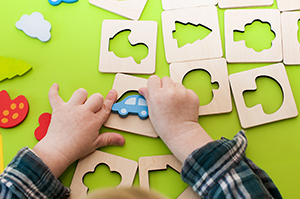Problem-solving by definition is “the process of finding solutions to difficult or complex issues.” Henry Kaiser states, “Problems are only opportunities in work clothes.”
How do we turn problems into opportunities so our children become problem solvers? Children learn best through modeled behavior, which is then practiced through play and everyday tasks. Consider puzzles; when children are young we give them puzzles that are simple. They match the shape with the matching cut out. Then as they get older and their fine motor skills develop, you give them puzzles with 12-24 pieces and are interlocking. They use their skills to learn to put these shapes together to create a picture. As your child learns to solve those puzzles they will be able to complete puzzles with smaller pieces and an increased piece count.
7 ways to teach your child to problem solve
- Allow Failure
- Give your child space. Allow them to make mistakes and encourage them to try again. Resist the urge to fix or do it for them.
- Encourage creative play
- Make sure their play includes imagination; building forts, building with blocks, obstacle courses. These activities will naturally require problem solving.
- Give your child choices
- Making decisions is key to problem solving. Start with a simple choice for younger children. For example: “Do you want to wear the blue shirt or the red shirt?”
- Read problem-solving stories
- Use stories to inspire, as well as model, problem solving skills
- Be hands-on
- Step by step do-it-yourself projects are a great place to model problem solving skills. Ask your child questions along the way.
- Ask Questions
- Identify problems, work with your child to break the problems down into manageable parts, make a list of the tasks needed to resolve the problem. Practice brainstorming and sharing ideas. Ask your child what they think about the problem and encourage them to find a solution on their own.
- Give them a hunger for innovation
- Let them discover how things work, ask questions like, “How would you make this better?” Encourage curiosity – “Why do you think it happens this way?”
- Creativity
- Researching Skills
- Data Collections
- Data Analytics
- Team Working
- Emotional Intelligence
- Risk Management
- Decision Making
- Presentation Skills
We can develop great problem-solving experts by having them learn and practice problem solving from kindergarten to high school graduation.
We need to teach hands-on statistically based problem solving with innovative solutions that solve technical and non-technical problems.
Michael Arnold TEDxGreenville
Where can I find activities that teach Problem Solving?
Rachel & the TreeSchoolers Signs and Science Learning System incorporates the best elements of Schoolhouse Rock, Mr. Rogers and Sesame Street to deliver a well-rounded preschool science curriculum for ages 2-6. This Science Learning System:

- lets your child go to preschool with Rachel from Signing Time!
- actively engages children in learning
- teaches values like kindness, teamwork and sharing
The Rachel & the TreeSchoolers Science in Action Series give you fun science experiments that require problem solving skills. These activities are great for Preschool & Elementary students.
Sign-up for Science in Action emails
Resources:
How to Teach Kids Better Problem Solving | Michael Arnold | TEDxGreenville
Problem Solving in Early Childhood Classrooms. by Joan Britz ERIC Digest.
What Is Problem Solving? by Mind Tools Content Team
10 ways to teach your children to be problem solvers All Pro DAD
Five ways to foster a hunger for innovation in children by entrepreneur.com
Abode Stock Photos 135600578, 189083202, 116737944



